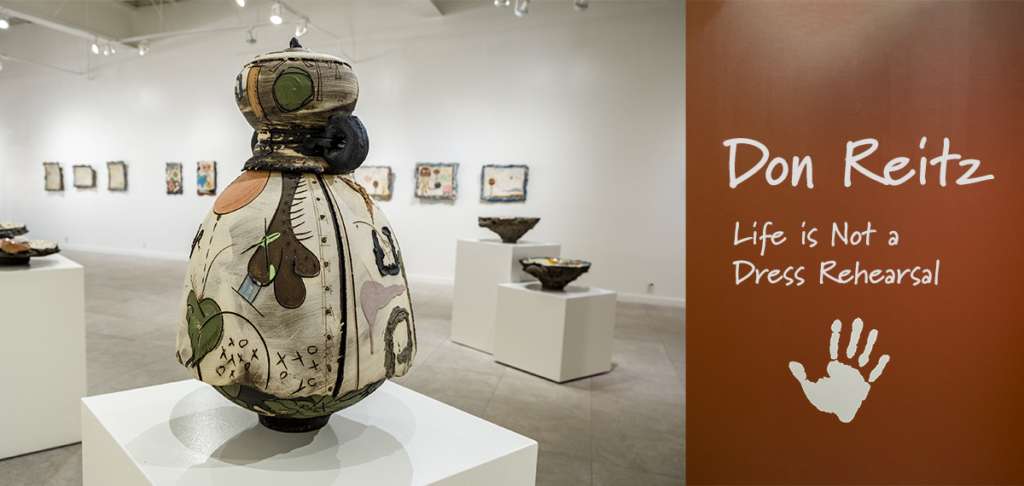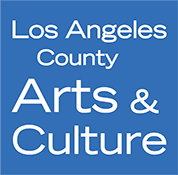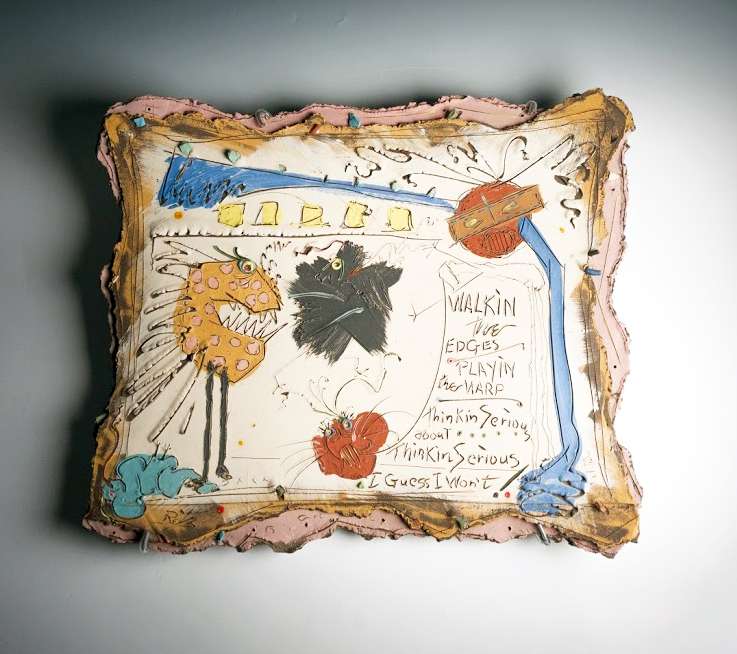
Don Reitz: Life is Not a Dress Rehearsal
| On View: | June 4, 2021–February 20, 2022 |
| Reception: | Saturday, September 11, 2021 • 3–5 PM |
| Catalog: | Don Reitz |
The exhibition Don Reitz: Life is not a Dress Rehearsal features the work of Don Reitz, an artist broadly recognized as one of the most influential American ceramic artists of the last century. Known by many in the ceramics community as “Mr. Salt” for his role in almost single-handedly reviving the salt-fire tradition in American studio ceramics, the New York Times recognized Reitz as “one of a small cadre of midcentury artisans who expanded the medium to include immense, intellectually provocative works of abstract art” (New York Times, March 30, 2014). This exhibition will add to the significant body of scholarship on Reitz’s work with new research on the well-known but largely unstudied “Sara Series” (1983-91). This exhibition will feature, together for the first time, over 40 works from this series.
The catalyst for this body of work is no less dramatic than the work itself. “In 1982 Reitz nearly lost the use of his left arm and leg in a serious truck accident. Laid up for months and in constant pain,” he sank into a deep depression (Don Reitz: Clay, Fire, Salt, and Wood, Clowes). It is during this period of despair that Reitz’ father passed away and his niece, Sara Gula, was diagnosed with cancer. A regular exchange of letters and drawings between Reitz and his niece saw them through the worst of their convalescence.
From this correspondence, Reitz drew new inspiration. “Fired with fury and devotion” from the shared tragedies, Reitz returned to the studio and began producing a torrent of new work (Clowes). His students rolled clay slabs, and on them Reitz painted with vivid colors images from Sara and from his childhood: “trains and fishing holes…long-toothed monsters and broken flowers, all wrapped together with a swift, thin, anxious line” (Clowes). The “Sara Series” was born.
The artistic significance that the “Sara Series” held for Reitz has not been thoroughly examined. For almost half a decade preceding this body of work, Reitz had been experimenting in a variety of mediums and modes without – in his own words – success. “[P]hoto-transfers…unfired clay, plate glass, sausage casings, trophy heads, water, and (once) live fish” were all tried; “[I had] lost [my] north” (Clowes). The “Sara Series” played a critical role in reconnecting Reitz to his artistic process and reinvigorating his artistic production. It ignited the following 30 years of work and set the stage for his acclaimed wood-fire period.
Don Reitz (1929-2014) was named twice during his lifetime as one of the most influential ceramic artists alive, and received numerous awards, including the first Ceramic Art Award from the American Ceramic Society, the Aileen Osborn Webb Gold Medal from the American Crafts Council, and the Distinguished Educator Award from the James Renwick Alliance. Reitz is primarily known for two bodies of work: his salt-fired works and his wood-fired works. The former was largely produced during the first 20 years of his career, and the latter took up the final three decades of his career.
A child of the Great Depression, Reitz served in the Navy as a salvage diver before exploring life as a truck driver, sign painter, and butcher. The G.I. Bill allowed Reitz to enroll in college, and after a semester at Kutztown State Teacher’s College he was hooked on clay. After receiving his bachelor’s degree in 1957, Reitz taught in Dover, NJ public schools for a few years before enrolling at Alfred University where he earned his master of fine arts degree in 1962. He subsequently joined the faculty at the University of Wisconsin, Madison, where he taught 1962-88. In 1988, he relocated to a ranch and built a studio in Clarkdale, AZ.
His prodigious body of work is represented in over 50 distinguished public and private collections including: American Museum of Ceramic Art (CA), Arkansas Arts Center, Arizona State University Art Museum, Chazen Museum of Art (WI), Contemporary Art Museum, (HI), Daum Museum of Contemporary Art (MO), De Young, Fine Arts Museums (CA), High Museum of Art (GA), Los Angeles County Museum of Art (CA), Milwaukee Museum of Art (WI), Mint Museum of Craft + Design (NC), Museum of Ceramic Art, Alfred University (NY), Museum of Fine Arts, Boston (MA), Museum of Fine Arts, Houston (TX), Smithsonian American Art Museum (DC), and the Weismann Art Museum (MN). His papers are held at the Smithsonian Archives of American Art.
This exhibition is funded, in part, by:


Bring Some Culture to Your Inbox
399 N Garey Ave Pomona, CA 91767
909.865.3146 | info@amoca.org
The museum is open Fridays, Saturdays, and Sundays, 11 AM–4 PM. Plan your visit by clicking here.
For information about Ceramics Studio hours and availability, please click here for the Ceramics Studio.
